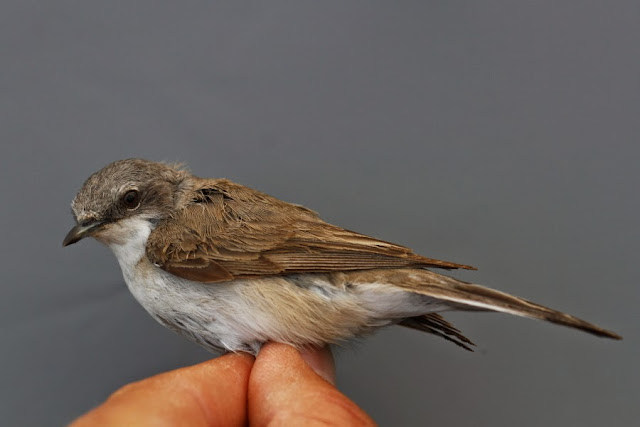UPDATE: The result of the genetic analysis concludes that it had mitochondrial DNA belonging to Sylvia curruca curruca. As the difference in nuclear DNA between curruca and blyth is very little, it is however difficult to exclude a mixed origin. Nevertheless, we can say with confidence that the bird falls into the curruca clade as defined in the recent paper by Olsson et al (2013) and moreover, at least its mother was a nominate curruca.
*********
During mist netting at Totten on the eastern most tip of Anholt we caught surprisingly many 2cy Lesser Whitethroats. Because of the possible blythi from the week before I paid extra attention to their song, but all the types we heard were of the western curruca type.
Early morning on June 1, 2014 something quite different was suddenly heard singing with a distinct song. As my sound recording equipment was already running nearby in order to get migrant calls, I just grabbed it, and went for the song. Luckily the bird continued to sing for several minutes at close range and showed quite well in the early morning light. As the song was very characteristic and its plumage distinct, the possibility that is was in fact a Siberian Lesser Whitethroat Sylvia curruca blythi was emidiatly considered. The bird had rather faded brownish upperparts and some smudging on the underparts and was thus quite different from most of the other Lesser Whitethroats seen.
Luckily, it moved into some trees near one of my mist nets and with less than one minute of playback, it dived straight into the net. A wide range of biometric measures were recorded and a feather sample secured for future DNA analysis before it was released again.
The bird was heard singing more than fifty times and always with the same rapid cycling song. Listen to the two recordings below to hear how distinct it was. Could this cycling song without the classic curruca rattles be unique for Siberian Lesser Whitethroat and thus allow us to make safe field identifications in spring just like in Siberian Chiffchaff?
The two recordings above are from Anholt, whereas I made the two below in Feldballe. Listen to the similarities between the two birds:
... and compare the two birds in the four recordings above with the songs in these two below from Lake Baikal by Magnus Hellström:
21/5-2014
|
1/6-2014
|
|
Feldballe
|
Anholt
|
|
blythi?
|
blythi?
|
|
Metal ring no.
|
9L62761
|
BX06856
|
Age & sex
|
2cy male
|
2cy male
|
Wing length (max)
|
63.7 mm
|
65.0 mm
|
Tail length
|
55.1 mm
|
56.85 mm
|
Tail/Wing ratio (x100)
|
86.4
|
87.5
|
Bill to skull length
|
10.4 mm
|
10.23 mm
|
2nd P
|
= P6
|
= P6
|
Wing tip
|
P3
|
P3-P4
|
Bill height (front nostrils)
|
2.9 mm
|
2.81
|
Bill height (rear nostrils)
|
3.3 mm
|
3.14
|
Bill width (front nostrils)
|
2,75 mm
|
3.15 mm
|
Bill width (rear nostrils)
|
3.3 mm
|
4.59 mm
|
Tarsus length
|
22.1 mm
|
21.58
|
1st P > Alula
|
12.5 mm
|
12.15 mm
|
1st P > PC
|
5.4 mm
|
3.64 mm
|
Wing tip > longest tertial
|
12.3 mm
|
13.52 mm
|





Ingen kommentarer:
Send en kommentar